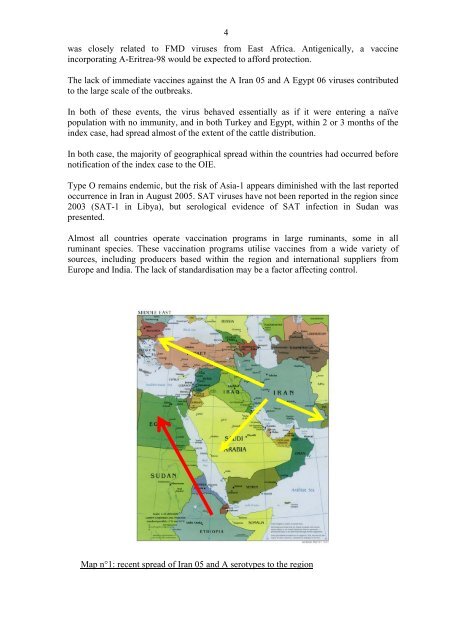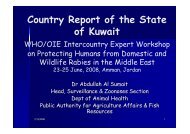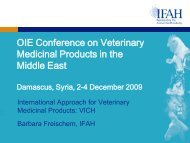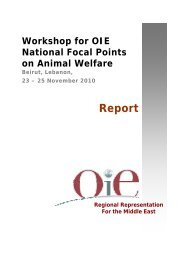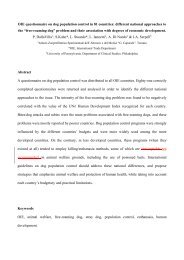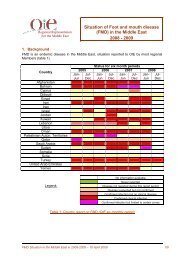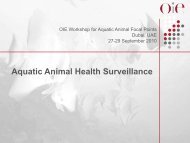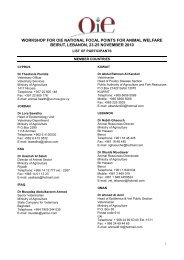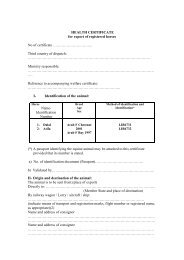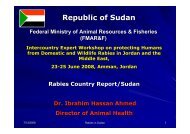FMD in the ME: Perspectives and risks linked to ... - Middle East - OIE
FMD in the ME: Perspectives and risks linked to ... - Middle East - OIE
FMD in the ME: Perspectives and risks linked to ... - Middle East - OIE
Create successful ePaper yourself
Turn your PDF publications into a flip-book with our unique Google optimized e-Paper software.
4was closely related <strong>to</strong> <strong>FMD</strong> viruses from <strong>East</strong> Africa. Antigenically, a vacc<strong>in</strong>e<strong>in</strong>corporat<strong>in</strong>g A-Eritrea-98 would be expected <strong>to</strong> afford protection.The lack of immediate vacc<strong>in</strong>es aga<strong>in</strong>st <strong>the</strong> A Iran 05 <strong>and</strong> A Egypt 06 viruses contributed<strong>to</strong> <strong>the</strong> large scale of <strong>the</strong> outbreaks.In both of <strong>the</strong>se events, <strong>the</strong> virus behaved essentially as if it were enter<strong>in</strong>g a naïvepopulation with no immunity, <strong>and</strong> <strong>in</strong> both Turkey <strong>and</strong> Egypt, with<strong>in</strong> 2 or 3 months of <strong>the</strong><strong>in</strong>dex case, had spread almost of <strong>the</strong> extent of <strong>the</strong> cattle distribution.In both case, <strong>the</strong> majority of geographical spread with<strong>in</strong> <strong>the</strong> countries had occurred beforenotification of <strong>the</strong> <strong>in</strong>dex case <strong>to</strong> <strong>the</strong> <strong>OIE</strong>.Type O rema<strong>in</strong>s endemic, but <strong>the</strong> risk of Asia-1 appears dim<strong>in</strong>ished with <strong>the</strong> last reportedoccurrence <strong>in</strong> Iran <strong>in</strong> August 2005. SAT viruses have not been reported <strong>in</strong> <strong>the</strong> region s<strong>in</strong>ce2003 (SAT-1 <strong>in</strong> Libya), but serological evidence of SAT <strong>in</strong>fection <strong>in</strong> Sudan waspresented.Almost all countries operate vacc<strong>in</strong>ation programs <strong>in</strong> large rum<strong>in</strong>ants, some <strong>in</strong> allrum<strong>in</strong>ant species. These vacc<strong>in</strong>ation programs utilise vacc<strong>in</strong>es from a wide variety ofsources, <strong>in</strong>clud<strong>in</strong>g producers based with<strong>in</strong> <strong>the</strong> region <strong>and</strong> <strong>in</strong>ternational suppliers fromEurope <strong>and</strong> India. The lack of st<strong>and</strong>ardisation may be a fac<strong>to</strong>r affect<strong>in</strong>g control.Map n°1: recent spread of Iran 05 <strong>and</strong> A serotypes <strong>to</strong> <strong>the</strong> region


